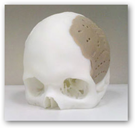This is a great use for 3-D printing a model can be built with  customized specifications. One might wonder someday if we could see knees and hips produced this way? Obviously it would be much more of a process and maybe some of the parts could be created this way. Here’s a couple other examples of 3-D printing at work. With a scan it can take just 2 weeks to create the model.
customized specifications. One might wonder someday if we could see knees and hips produced this way? Obviously it would be much more of a process and maybe some of the parts could be created this way. Here’s a couple other examples of 3-D printing at work. With a scan it can take just 2 weeks to create the model.
Woman Receives Jaw Transplant-Created by a 3D Printer–She Can Swallow Again at 83 Years of Age-Regenerative Printed Medicine
Need a Prosthetic Leg–3D Printing Will be Able to Generate One for You Soon for Around $5000
From the Website:
“In addition to the importance of implant fit, implant material is a critical consideration. The OPSCD is manufactured from PEKK, an ultra high performance polymer used in biomedical implants and other highly demanding applications. OPM had traditionally sold PEKK as a raw material or in a semi-finished form, but began developing Additive Manufacturing technologies in 2006. In 2011, OPM established a biomedical compliant manufacturing facility in South Windsor, CT to support its growing Additive Manufacturing business. As an implantable polymer, PEKK is unique in that is biocompatible, mechanically similar to bone, and radiolucent so as not to interfere with X-Ray equipment. Furthermore, OPM has recently completed testing which confirms that the OsteoFab™ implant surface is, in fact, osteoconductive.”
I can’t wait until teeth become more mainstay as well for dental implants and it’s getting there. I had the chance to see one at a conference last year that merged with another 3-D company, Objet shows how theirs works and more videos at the link below, fascinating. BD
Two 3D Printing Companies Merging Stratasys and Objet–A Growing Area of Technology For Healthcare
An unidentified man had 75% of his skull replaced with a 3-D printed implant made by Oxford Performance Materials, a
 Connecticut company. The surgery this week was the first time a patient received an implant made specifically for him using 3-D printing technology.
Connecticut company. The surgery this week was the first time a patient received an implant made specifically for him using 3-D printing technology. The patient, whose name and injury OPM would not disclose, had his head scanned as part of the procedure.
The operation marks a big step in the advancement of 3-D printing technology, the company said. With 3-D printers, users can produce objects with a molding machine based on computer digital models.
The type of implant, which is formally known as the OsteoFab Patient Specific Cranial Device, is made out of PEKK, an ultra-high-performance polymer, according to the company's website.
The U.S. Food and Drug Administration approved OPM's technology last month, clearing the way for the surgery.
http://www.latimes.com/business/technology/la-fi-tn-skull-3dprinted-implant-75-20130308,0,7338719.story



0 comments :
Post a Comment